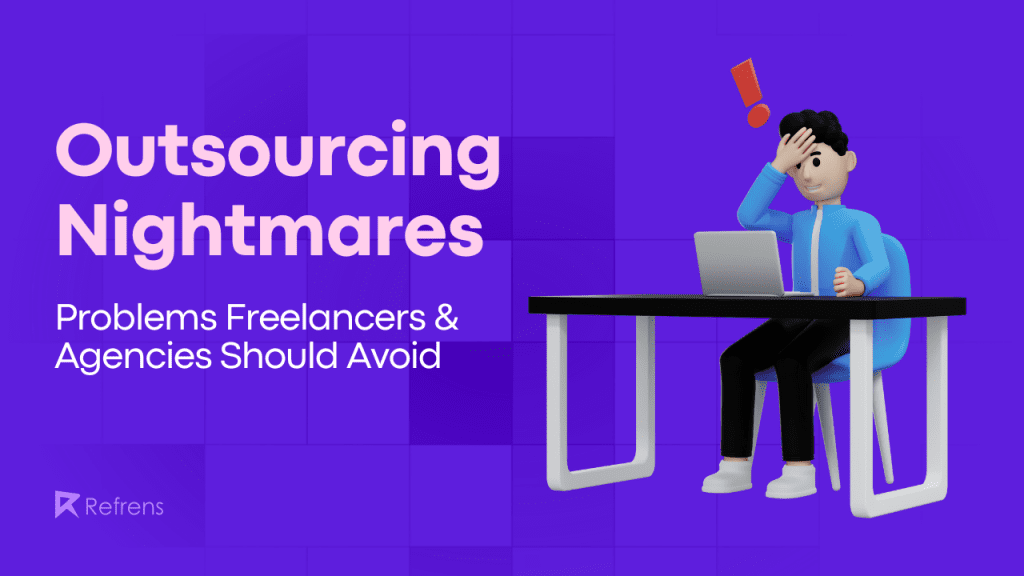Gone are the days of being limited by geography or time zones. Now, businesses can collaborate with freelancers and agencies from different countries and time zones, allowing them to work around the clock.
Whether it’s reducing costs, accessing specialized skills, or improving efficiency, outsourcing can be the magic lamp that unlocks a business’s full potential!
However, outsourcing is not always smooth sailing. It comes with its fair share of challenges.
As a freelancer, you very well know that sometimes the client relationship can be like a rollercoaster ride – full of ups and downs. While some projects may end with a high-five and a glowing review, others may leave you feeling like you’ve been thrown off the ride altogether.
Although this is a fact, it’s important to encourage businesses to continue outsourcing while also avoiding difficult situations with clients.
Curious to know what outsourcing nightmares you, as a freelancer/agency, can avoid?
Keep reading this article to find out.
Criteria for Evaluating Expectations in Outsourced Work
In an outsourced work, managing client’s expectations is crucial for ensuring the success of the project. Before you can do that, let’s first understand the parameters at play.
1. Scope Of Work
One of the key parameters for measuring expectation is the scope of work. This involves defining the specific tasks and deliverables that the freelancer/agency is responsible for, as well as outlining any limitations or constraints.
The key aspect to consider here is the expected final delivery. Even a minor difference such as expecting a PDF file and receiving a word file can lead to dissatisfaction.
The scope of work is essential in ensuring that the project stays on track, and should be agreed upon by both parties before any work begins.
Check out the 7 steps for starting an agency.
2. Discipline and Punctuality
Meeting deadlines is crucial in any business relationship, and outsourced work is no exception. It is imperative that both parties adhere to the timelines to achieve successful project completion.
On the one hand, freelancers/agencies must be disciplined and punctual in their work, completing tasks on time and meeting agreed-upon deadlines.
On the other hand, businesses must be responsive and timely in providing feedback and making decisions to ensure that the work stays on schedule.
Check out the tips to juggle multiple clients as a freelancer.
3. Communication
Effective communication ensures that both parties have a clear understanding of the project’s goals, timelines, and requirements.
It’s important to establish clear communication channels like email, whatsapp, G-meet and expectations for how and when communication will occur, such as regular check-ins or progress updates.
Additionally, this can help prevent the disappointment and dissatisfaction that often arise at the end of a project when payment is due.
4. Payment & Payment Terms
This includes determining the payment schedule, payment amount, and any other conditions or requirements related to payment.
Imagine you’re a freelance graphic designer who has been hired by a client to create a logo for their business. You agreed on a payment of $500 for the project, with $250 due upon completion of the initial design and $250 upon final approval of the logo.
You deliver the initial design, and the client is happy with it, but they take several weeks to provide feedback on the revisions. Eventually, they approve the final design, and you submit the invoice for the remaining payment.
However, the client disputes the payment, claiming that they were not satisfied with the final product and that it did not meet their expectations.
This leads to a payment dispute that can harm the relationship between you and the client and cause financial and legal problems for both parties.
Check out the 5 tips to collect faster payments.
Outsourcing Nightmares To Avoid As A Freelancer/Agency
Problem 1 – Having No Written Communication
The first nightmare to avoid as an agency/freelancer is not having written communication. This not only leads to misunderstanding and missed deadlines but also an overall sense of confusion.
Sure, verbal communication is great for building relationships and getting to know someone, but when it comes to work, it’s all about the written word.
Why, you may ask?
For one thing, written communication provides a record of what was said, when it was said, and who said it. This can be incredibly useful if there are any disputes or misunderstandings down the line.
Solution
Establish clear lines of written communication from the get-go. Use project management tools like Trello or Asana to keep everyone on the same page. This is especially simple if you use a project management tool with a portal for clients.
And remember — even if you started with a solid contract, it’s always possible for things to change along the way.
For example, if a client initially requested to create a website with a certain number of pages, but later decided to add more pages and features, the scope of work and payment terms should be revised accordingly.
Also as a freelancer/agency the onus of recording is on you. It is not advisable to rely on the client for this task.
Problem 2 – Delegation On Either Side & No Single POC (point of contact)
Delegation can be an excellent way to lighten the workload, develop new skills and build trust within a team. However, delegation can also lead to several problems, particularly accountability.
If something goes wrong with the project, it can be challenging to pinpoint who is responsible, particularly if multiple parties are involved. This can lead to a lot of finger-pointing and blame-shifting.
Moreover, delegating work to an external party can also mean a loss of control over the project.
It can be difficult to know whether the work is being done to the standards and expectations of the client, and this can lead to frustration and dissatisfaction
Furthermore, if there are multiple individuals responsible for communicating with the client, it can give off an unprofessional impression.
Solution
Establish a single POC on both sides, someone who is responsible for ensuring that tasks are completed on time and to the expected level of quality.
If there are any changes in the Point of Contact (POC) from either side during the course of the project, it’s important for the new person to compile the progress and pathway that has been established so far and communicate it effectively with the client.
Problem 3 – Hitting Below The Weight Class
Have you ever started a project only to discover it’s a time-sucking, soul-crushing endeavor that leaves you questioning your life choices?
Perhaps you saw some worth while onboarding the client, but now that you have more pressing matters, you may have lost interest in it.
When you find yourself in such situations where you no longer have the time or interest to continue with a project, it is crucial to communicate clearly to maintain your reputation.
Solution
Both parties can then reach a mutual agreement to delegate the project to another freelancer/agency, allowing to part ways on good terms rather than over-promising and ultimately under-delivering.
And the ideal foremost thing to do would be to perform due diligence before onboarding a client. As a freelancer/agency, these questions can help you do that –
- Am I onboarding the client because I am interested in the project or because I have free time?
- Is the amount of time needed worth my effort?
- Is the project helping me optimize my skills or my reputation, for the longer run?
Doing your homework before taking on new projects can make all the difference in achieving success!
Check out the ways to minimize the risk while working with new clients.

Summary
The article discusses outsourcing nightmares that freelancers and agencies should avoid. It highlights three major problems that can arise in outsourced work – no written communication, no single point of contact, and hitting below the weight class,
The first issue stresses the importance of documenting all communication in writing to avoid misunderstandings and disputes related to payment and other terms.
The second issue emphasizes the need for a single point of contact to ensure clear communication and avoid confusion among team members and clients.
The third issue refers to taking on projects that are above/beyond one’s capabilities, leading to dissatisfaction and negative reviews.
By addressing these problems, freelancers and agencies can avoid being in difficult situations with the client and build successful business relationships.
Also read: How to decide between hiring In-house vs freelancers or agency engagement>


















